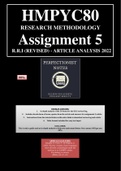Class notes
HMPYC80 assignment 5 R.R.I (revised) 2022 - research methodology
- Course
- Institution
Not a memo: In-depth guide and analysis 2022. ARTICLE: Sibanda, S.; Guse, T.; & Chigeza, S. (2021) Psychic wounds of post-traumatic stress disorder camouflaged under the uniform of an SAMDF soldier. Psychology in society (PINS), 62, 87-115. CONTAINS:Definitions, extracts from articles and more. Tab...
[Show more]



